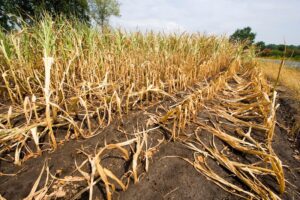继中国的二氧化碳(CO2)排放量在2024年第二季度出现下降后,第三季度碳排放量与去年同期持平或略低。
Carbon Brief基于官方和商业数据进行的最新分析显示,三季度的数字意味着今年中国全年碳排放量仍有可能下降。

然而,最近创纪录的高温导致九月份的排放量上升,加之新的经济刺激措施出台,使得中国的排放轨迹现在面临更大的不确定性。
在今年八月和九月的大部分时间里,肆虐的热浪导致空调用电需求大幅上升,再加上水电出力不足,导致第三季度燃煤发电量增长2%,燃气发电量增长13%,尽管风电和太阳能发电量的增长继续打破纪录。
电力部门的排放量增加被钢铁、水泥和石油使用产生的排放量减少、以及电力部门以外的天然气需求停滞所抵消。因此,中国第三季度的碳排放量较去年同期基本持平或略有下降。
该分析的其他关键调研结果包括:
- 第三季度太阳能发电量同比增长44%,风电增长24%,两者的新增装机容量继续创纪录。
- 与去年受干旱影响的数据相比,水力发电量增长了11%,但仍未达到预期水平。核电增长了4%。
- 由于建筑活动减少、电动汽车和天然气卡车的增加以及消费疲软,石油需求下降了约2%。
- 第三季度,钢铁和水泥行业的排放量分别下降了3%和12%,这两个行业都继续受到建筑活动下降的影响。
- 煤化工行业获得了新的政策支持,导致该行业的煤炭消费量年初至今增长近五分之一。
若要使中国2024年总排放量低于2023年水平,第四季度三个月的碳排放量需至少下降2%。工业用电需求增长放缓以及空调季的结束将助力实现这一目标。
然而,北京在九月底宣布的新经济刺激计划并未明显强调碳排放问题,这给排放量下降的前景增加了不确定性。
无论如何,中国仍将偏离其2025年“碳强度”目标,该目标要求该国在2020至2023年碳排放快速增长之后,在2024年和2025年排放量都需减少至少2%。
就未来而言,决策者最近透露了中国在碳达峰和减排方面的新计划,表明该国将采取渐进而谨慎的方式,这与实现《巴黎协定》目标所需要的水平有差距。
但是,如果中国清洁能源的快速增长能够持续,它有可能更快地实现减排。
清洁能源扩张满足夏季全部电力需求增长
尽管此前有预测显示中国的电力需求增速将放缓,但2024年第三季度实际电力需求同比增长了7.2%,高于第二季度的6.9%。
然而,电力需求增长的构成有所变化,大约60%的需求增长来自住宅和服务行业,其中家庭需求猛增了15%。
工业电力需求增长继续放缓,七月至九月增长了4.6%,低于第二季度的5.9%。
与此同时,太阳能发电量同比增长44%,风电增长了24%。尽管水电利用率不足,但仍同比增长了11%。核电的增长仅为4%,主要是由于新建核电机组较少。
电力需求的迅速增长超过了低碳能源供应的增长。为填补供需之间的缺口,燃煤发电量增长了2%、燃气发电量增长了13%,如下图所示。
这导致该季度电力部门的碳排放量增加了3%。

然而,纵观整个夏季,无论是从五月到九月,还是从六月到八月,清洁能源的扩张都足以覆盖电力需求的全部增长。
今年八月和九月比去年更热,导致空调用电需求迅速增长。相比之下,去年六月和七月气温更高。
尽管住宅用电需求快速上升,但夏季燃煤和燃气发电量总体上有所减少,六月下降了7%,七月下降了5%,八月上升了4%,九月上升了9%。单月的增长率受极端高温出现时间的影响显著。
就新增发电装机容量而言,太阳能持续打破去年纪录,2024年初至九月新增装机容量达163GW,相当于德国、西班牙、意大利和法国四个拥有最多太阳能装机容量的欧盟国家的总和。第三季度中国太阳能装机同比增长22%。
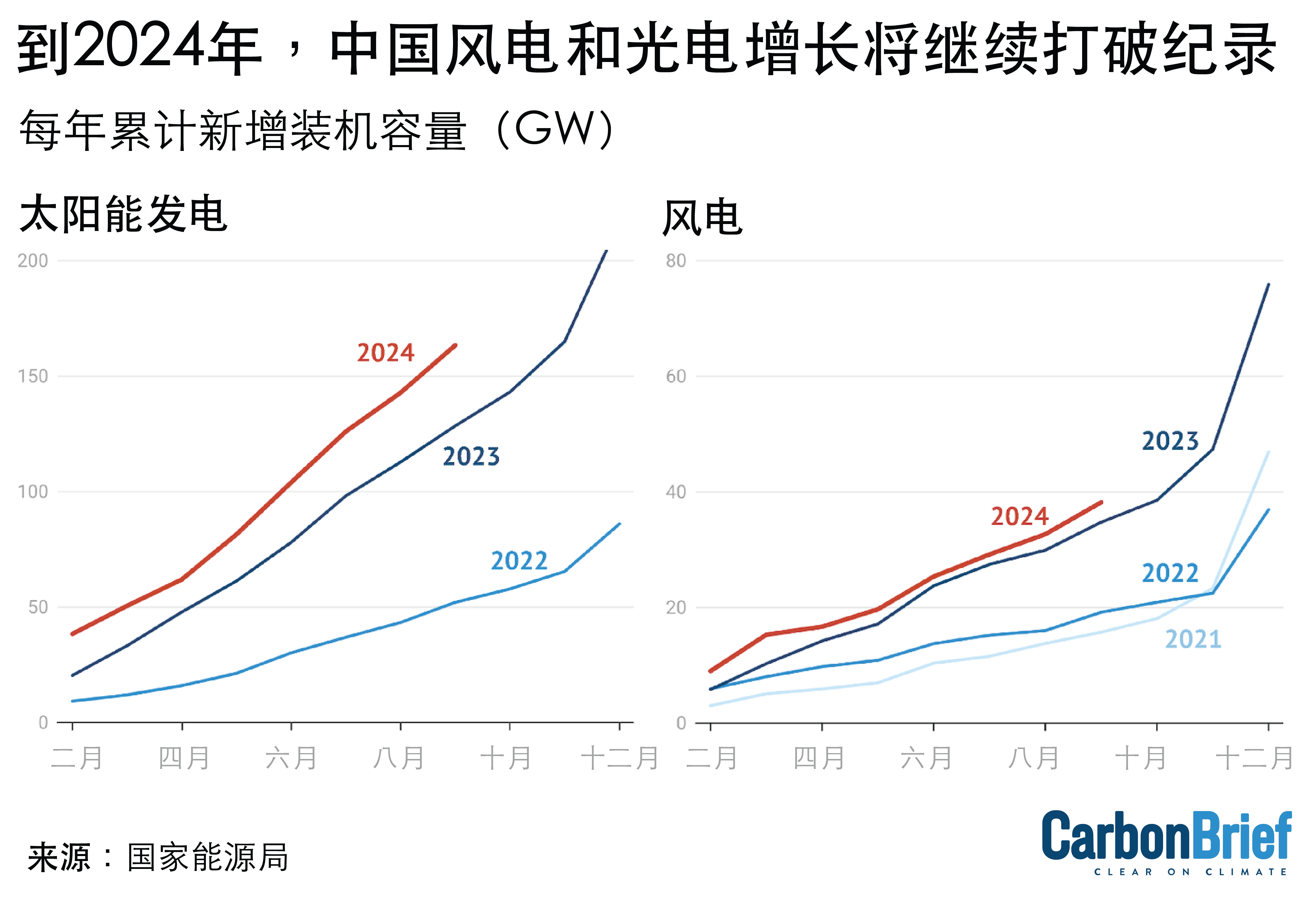
根据今年前九个月的增速,仅今年中国太阳能发电量的增长就可能相当于澳大利亚或越南在2023年的总发电量。
风电装机也加速增长,截至九月新增了38GW,同比增长10%,超过英国的总风电装机容量(30GW)。
今年八月,国务院一次性核准了11台新核电机组,获批项目的总发电装机容量约13GW。继2022年和2023年各核准10台核电机组后,2024年迄今批准的11台机组标志着中国下一批核电产能正在启动,将助力清洁能源增长。
在第三季度,水电装机仅同比增长2%,意味着11%的发电量增长主要源自利用率的恢复。由于严重干旱,水电利用率在2022年跌至十年来最低,2023年仅部分恢复,今年的反弹已接近预期平均水平。
2024年上半年,中国新核准的煤电项目骤降了80%,仅批准9GW,相比去年同期的52GW大幅下降。然而,根据能源资讯提供商Polaris Network的数据,第三季度有八个大型煤电项目获批,显示核准量可能在下半年有所增加。
建筑和石油需求放缓继续拉低总排放
虽然电力行业的碳排放在2024年第三季度出现了小幅增长,但工程量的持续萎缩拉低了总排放量。
因此,第三季度中国的碳排放量保持平稳,与去年同期水平持平或略低,如下图所示。
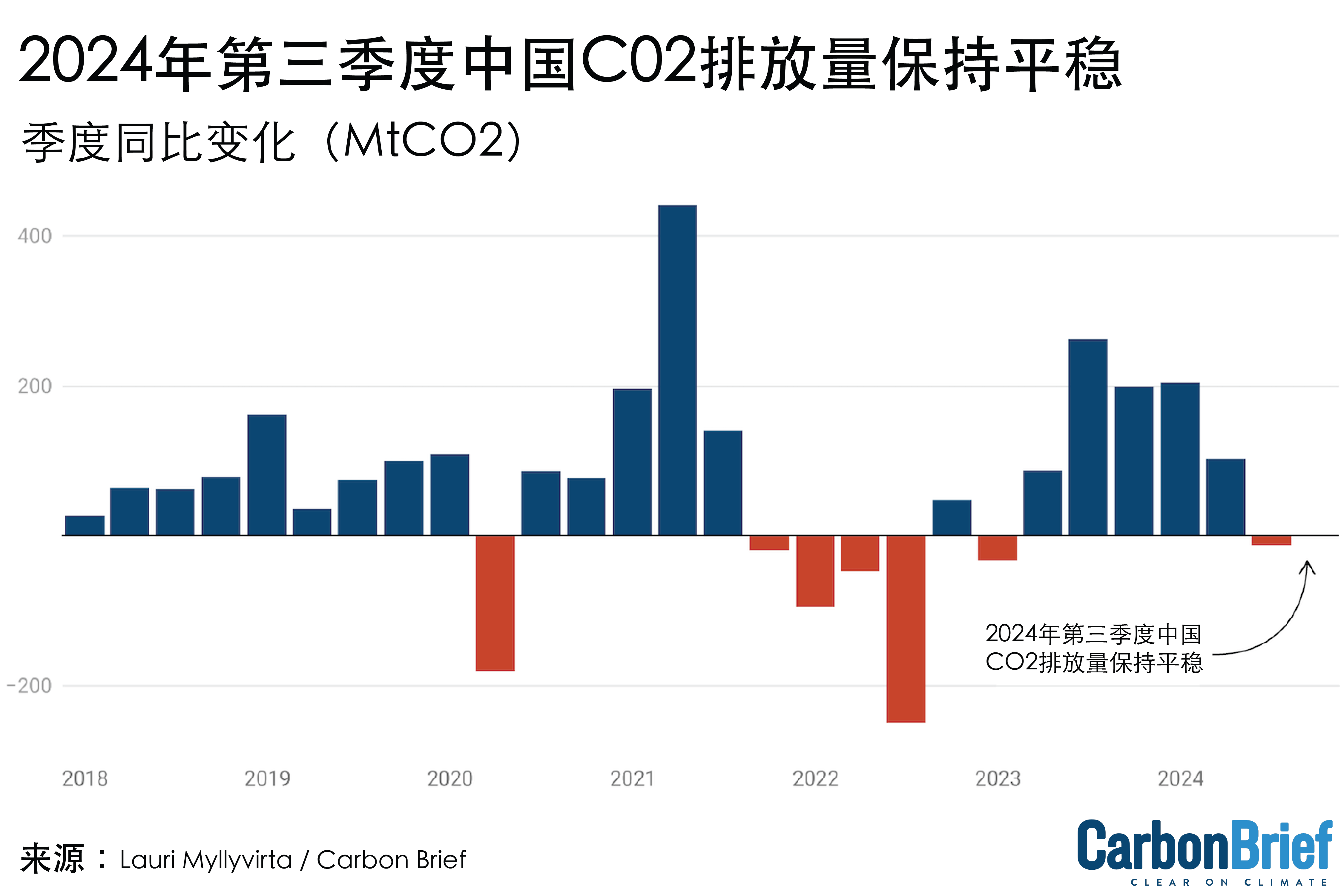
如果剖析建筑业导致的除电力行业以外的排放下降会发现,第三季度钢铁产量下降9%,水泥产量下降12%,房地产投资萎缩10%,与上半年持平。
这导致与2023年同期相比,水泥相关碳排放量减少了11%(24MtCO2),如下图所示。
尽管钢铁产量下降了9%,但钢铁相关排放量仅下降了3%(13MtCO2),原因在于需求下降的冲击主要由电弧炉炼钢厂承担,而不是排放强度高得多的燃煤高炉炼钢厂。
中国钢铁行业缺乏优先发展电弧炉的激励机制。电弧炉使用回收废钢,排放量较低。理论上,将钢铁纳入中国的碳排放权交易市场可能会促进转型。
然而,如果对该行业采取与电力行业相同的方式,对燃煤高炉炼钢和电炉炼钢设定不同的基准,则难以激励电力转型。
为推动钢铁行业结构性变革,中国工信部颁布政策,暂停所有新增钢铁产能的核准,将年初以来的实际停止审批变成正式禁令。直至去年,该行业仍在大规模投资煤基炼钢产能。

另一个排放下降的主要领域是石油消费,第三季度石油相关碳排放下降了2%(13MtCO2),如上图所示。该数据来自国家统计局。
石油需求和相关二氧化碳排放量的减少可能更多。石油产品供应量(以炼油厂扣除进出口后的产量计算)降幅更大。该指标显示,第三季度燃烧石油产生的碳排放下降了10%(63MtCO2),表明中国的二氧化碳总排放量或下降2%。
统计局报告的降幅要温和得多,这可能反映了中国统计数据趋于平缓化的特点。另一种可能的解释是,炼油厂以前的产量超出了消费需求,现在不得不削减产量以减少库存。
无论石油消费量下降的幅度如何,其下降原因已显而易见。工程量减少是重要因素,因为很大一部分柴油用于建筑工地和运输建筑材料。
电动车份额的增加也侵蚀了汽油需求量。家庭消费支出疲软也推动了需求减少,直到十月政府刺激政策出台后才出现回升迹象。
使用液化天然气的卡车的普及也对柴油需求形成抑制。2024年初至九月,液化天然气卡车销量占卡车总销量的20%,但天然气整体需求增长缓慢,表明这一影响有限。
天然气消费量增速从今年上半年的10%放缓至第三季度的3%。增量集中在电力行业,其他行业需求停滞,可能是由于工业需求疲软。
在经历了一二月排放量上升、三月至八月下降、九月再次增加后,年末三个月排放量需要至少下降2%,方能使中国的年度总排放量低于2023年水平。
由于工业电力需求增长的持续放缓和空调季的结束,这种情况很有可能发生。但即便如此,中国仍将偏离2025年的碳强度目标。该目标要求,在2020年至2023年中国排放量快速增长之后,在2024年和2025年都需至少下降2%。
排放量没有更快下降——甚至可能在第三季度根本没有下降——的根本原因是:今年能源消费量增速继续远超历史趋势。
第三季度,能源消费总量(包括但不限于电力消费量)增长了5.0%,快于GDP增长4.6%。
在疫情前,中国的能源需求增长一直低于GDP增速,这意味着经济的能源强度在下降。
然而,疫情后以制造业为重点的经济政策似乎扭转了这一趋势。
煤化工行业获得新的政策支持
中国碳排放前景中新增的一个变数是煤化工行业。该行业将国内煤炭转化为进口石油和天然气的替代品,尽管碳足迹要高得多。
国家发改委最近出台的政策要求“加快”煤化工行业的发展,包括“加快煤制油气战略基地建设”。
政策发布后数周,山西一个大型煤制油项目和陕西一个煤化工园区已开工建设,新疆也有类似项目获得核准。
据咨询公司中信建投期货称,2024年,煤化工行业的煤炭消费量预计将占中国煤炭总消费量的7%以上。
万得金融终端(Wind Financial Terminal)的数据表明,2024年前八个月煤化工行业的煤炭消费量增长了18%,2023年增长了9%。在今年一至八月期间,煤化工行业煤炭消费量增长所带来的排放占化石燃料碳排放总量增长的三分之二(总增幅为0.9%)。
然而,该行业的煤炭消费量增速在七月至八月放缓至5%,九月化工产品产量也继续放缓。上图(“化工”)显示了这个对碳排放量增长的较小推动因素。
近期油气价格上涨、加上中国增加国内煤炭产量和压低国内煤炭价格的努力,共同提振了对油价和煤价敏感的煤化工行业。
煤化工行业体现了中国是将能源安全,还是减排置于优先事项的直接矛盾。
经济刺激计划为排放前景增添不确定性
今年夏季的经济数据显示中国经济持续放缓、GDP增长未达目标,因此市场对当局出台刺激计划的预期随之增强。
政府在九月下旬宣布了一系列刺激措施,其主要针对金融市场,但也承诺要“稳定”房地产市场。
尽管该刺激计划的规模对于中国而言并不算大,进一步的细节也让那些希望政策出现更激烈转向的人感到失望,但该方案显然是经过深思熟虑后协调进行的,让外界得以一窥中国最高决策者正计划如何应对经济下行。
近年来广受关注的直接向家庭转移政府资金的措施,如今也将开始尝试。
这些措施旨在提振家庭消费,而非此前刺激政策重点的高能耗制造业和建筑业,若得以实施将让中国在更低能耗、低碳排的方式下实现增长。
然而,与整个一揽子计划的规模相比,直接转移资金的规模较小,且大部分资金用于汽车和家电补贴。这些补贴释放了家庭现金流,但同时也引导了家庭支出向最高耗能的领域集中。
大部分刺激资金仍通过地方政府借贷和银行贷款等传统渠道进行,这些资金通常用于工业和基础设施项目。
该刺激计划并没有明确着墨于气候。尽管相当一部分资金可能会流向与清洁能源相关的领域,但这只是因为这些投资最近在中国的投资流中占据主导地位,但该计划并未有额外政策推动此类投资。
决策者不认为碳排放会“提前”达峰
尽管清洁能源的快速增长似乎表明中国可能很快实现碳达峰,但决策者仍然预期碳排放量将在2030年之前继续增长,然后趋于平稳或逐渐下降。
今年八月,国家能源局在回应记者就有分析显示中国可能已实现碳达峰的问题时,淡化了这一可能性。
国家能源局相关部门负责人在回答这一问题时强调,国家领导层已确定“2030年前”为实现碳达峰的时间点,暗示该机构并无授权改变这一目标。
中共中央也在一份《意见》中重申,该国的目标是到2035年前让碳排放进入“下降趋势”。
国务院此前的一项计划表明,中国将在碳达峰后重点控制二氧化碳排放总量,而非排放强度,并表示这不会在2026至2030年期间发生。
根据中国目前在《巴黎协定》中的承诺,其允许采取一种非常渐进的方法来实现碳达峰并在达峰后减少排放,将更大幅度的减排留到未来几十年。
然而,这种路径将消耗全球1.5°C温控目标下90%的碳预算。若要限制全球气温上升至比工业化前高1.5°C以内,中国的排放量需在2035年之前至少比2023年水平下降30%。
国际能源署(IEA)最新分析指出,到2035年,中国等新兴市场需要将排放量减少到比2022年水平低35至65%的水平,以实现在COP28气候大会上做出的全球承诺或国家净零目标。
与中国决策者所传递的谨慎态度相反,若中国能保持当前的清洁能源扩展速度并推进电气化,到2035年,化石燃料的二氧化碳排放量将在2023年的水平上减少30%。
同样,国际能源署最新发布的《世界能源展望》(World Energy Outlook)发现,根据目前的政策方案,清洁能源的增长将有助于到2035年将中国的二氧化碳排放量减少到比2023年水平低24%。国际能源署表示,如果中国实现其宣布的雄心和目标,到2035年,碳排放量的削减将增加到45%。
根据《巴黎协定》,中国将于2025年2月前向联合国提交国家自主贡献(NDC)承诺,预计其将更清楚地说明决策者正在追求的减排途径。
关于数据
分析数据汇编自中国国家统计局、国家能源局、中国电力企业联合会和中国海关的官方数据发布,以及行业数据提供商万得资讯(WIND Information)的数据。
风能和太阳能发电量,以及按燃料划分的火电发电量系通过将每月末的发电装机乘月利用率计算得出,数据来自万得金融终端提供的中电联报告数据。
火电总发电量以及水电、核电发电量来自国家统计局月度发布数据。
由于没有生物质的月利用率数据,因此采用了2023年52%的年平均值。电力部门的煤炭消费量估算基于燃煤发电量和每月燃煤电厂的平均热耗率,以避免有争议的官方煤炭消费数据对近期其他产量数据的影响。
当数据来自多个来源时,本文对不同来源的数据交叉引用,并尽可能使用官方来源,调整总消费量以匹配国家统计局报告的第一季度、上半年和前三季度的消费增长和能源结构变化。数据调整对所有能源的影响不到1%。未经调整的数据显示,第三季度的排放量减少了1%。
二氧化碳排放量的估算基于国家统计局的默认燃料热值和中国最新的2018年国家温室气体排放清单中的排放因子。水泥的二氧化碳排放因子基于截至2023年的年度估算。
对于石油消费,表观消费量是根据炼油加工量计算的,并减去石油产品的净出口量。
The post 分析:尽管煤电反弹,但中国2024年三季度碳排放未增长 appeared first on Carbon Brief.
Greenhouse Gases
DeBriefed 3 October 2025: UK political gap on climate widens; Fossil-fuelled Typhoon Ragasa; ‘Overshoot’ unknowns
Welcome to Carbon Brief’s DeBriefed.
An essential guide to the week’s key developments relating to climate change.
This week
Shattered climate consensus
FRACKING BAN: UK energy secretary Ed Miliband has announced that the government will bring forward its plans to permanently ban fracking, in a move designed to counter a promise from the hard-right Reform party to restart efforts to introduce the practice, the Guardian said. In the same speech, Miliband said Reform’s plans to scrap clean-energy projects would “betray” young people and future generations, the Press Association reported.
ACT AXE?: Meanwhile, Kemi Badenoch, leader of the Conservatives, pledged to scrap the 2008 Climate Change Act if elected, Bloomberg reported. It noted that the legislation was passed with cross-party support and strengthened by the Conservatives.
‘INSANE’: Badenoch faced a backlash from senior Tory figures, including ex-prime minister Theresa May, who called her pledge a “catastrophic mistake”, said the Financial Times. The newspaper added that the Conservatives were “trailing third in opinion polls”. A wide range of climate scientists also condemned the idea, describing it as “insane”, an “insult” and a “serious regression”.
Around the world
- CLIMATE CRACKDOWN: The US Department of Energy has told employees in the Office of Energy Efficiency and Renewable Energy to avoid using the term “climate change”, according to the Guardian.
- FOREST DELAY: Plans for Brazil’s COP30 flagship initiative, the tropical forests forever fund, are “suffer[ing] delays” as officials remain split on key details, Bloomberg said.
- COP MAY BE ‘SPLIT’: Australia could “split” the hosting of the COP31 climate summit in 2026 under a potential compromise with Turkey, reported the Guardian.
- DIVINE INTERVENTION: Pope Leo XIV has criticised those who minimise the “increasingly evident” impact of global warming in his first major climate speech, BBC News reported.
€44.5 billion
The cost of extreme weather and climate change in the EU in the last four years – two-and-a-half times higher than in the decade to 2019, according to a European Environment Agency report covered by the Financial Times.
Latest climate research
- Fossil-fuelled climate change caused around 36% of Typhoon Ragasa’s direct damage to homes and properties in southern China, according to a rapid impact attribution study | Imperial Grantham Institute – Climate Change and the Environment
- Some 86% of the global population are concerned about climate change, according to a survey of 280,000 people in 142 countries and regions | Climate Policy
- A global shift towards a “planetary health diet” could slash emissions and save tens of thousands of lives each day | EAT-Lancet Commission 2025 report
(For more, see Carbon Brief’s in-depth daily summaries of the top climate news stories on Monday, Tuesday, Wednesday, Thursday and Friday.)
Captured
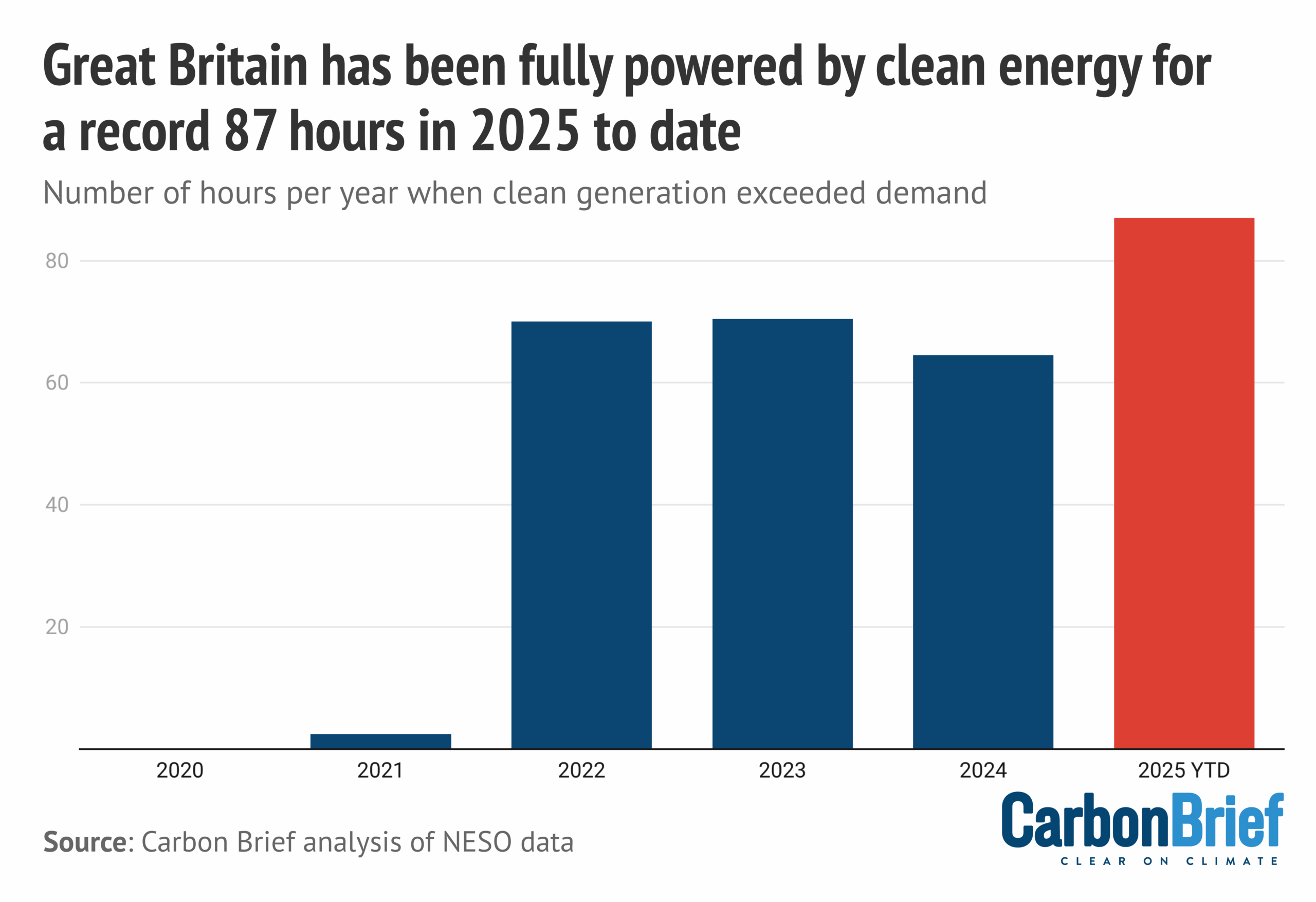
Clean energy has met 100% of Great Britain’s electricity demand for a record 87 hours this year so far, according to new Carbon Brief analysis. This is up from just 2.5 hours in 2021 and 64.5 hours in all of 2024. The longest stretch of time where 100% of electricity demand was met by clean energy stands at 15 hours, from midnight on 25 May 2025 through to 3pm on 26 May, according to the analysis.
Spotlight
‘Overshoot’ unknowns
As the chances of limiting global warming to 1.5C dwindle, there is increasing focus on the prospects for “overshooting” the Paris Agreement target and then bringing temperatures back down by removing CO2 from the atmosphere.
At the first-ever Overshoot Conference in Laxenburg, Austria, Carbon Brief asks experts about the key unknowns around warming “overshoot”.
Sir Prof Jim Skea
Chair of the Intergovernmental Panel on Climate Change (IPCC) and emeritus professor at Imperial College London’s Centre for Environmental Policy
So there are huge knowledge gaps around overshoot and carbon dioxide removal (CDR). As it’s very clear from the themes of this conference, we don’t altogether understand how the Earth would react in taking CO2 out of the atmosphere.
We don’t understand the nature of the irreversibilities and we don’t understand the effectiveness of CDR techniques, which might themselves be influenced by the level of global warming, plus all the equity and sustainability issues surrounding using CDR techniques.
Prof Kristie Ebi
Professor at the University of Washington’s Center for Health and the Global Environment
There are all kinds of questions about adaptation and how to approach effective adaptation. At the moment, adaptation is primarily assuming a continual increase in global mean surface temperature. If there is going to be a peak – and of course, we don’t know what that peak is – then how do you start planning? Do you change your planning?
There are places, for instance when thinking about hard infrastructure, [where overshoot] may result in a change in your plan – because as you come down the backside, maybe the need would be less. For example, when building a bridge taller. And when implementing early warning systems, how do you take into account that there will be a peak and ultimately a decline? There is almost no work in that. I would say that’s one of the critical unknowns.
Dr James Fletcher
Former minister for public service, sustainable development, energy, science and technology for Saint Lucia and negotiator at COP21 in Paris.
The key unknown is where we’re going to land. At what point will we peak [temperatures] before we start going down and how long will we stay in that overshoot period? That is a scary thing. Yes, there will be overshoot, but at what point will that overshoot peak? Are we peaking at 1.6C, 1.7C, 2.1C?
All of these are scary scenarios for small island developing states – anything above 1.5C is scary. Every fraction of a degree matters to us. Where we peak is very important and how long we stay in this overshoot period is equally important. That’s when you start getting into very serious, irreversible impacts and tipping points.
Prof Oliver Geden
Senior fellow and head of the climate policy and politics research cluster at the German Institute for International and Security Affairs and vice-chair of IPCC Working Group III
[A key unknown] is whether countries are really willing to commit to net-negative trajectories. We are assuming, in science, global pathways going net-negative, with hardly any country saying they want to go there. So maybe it is just an academic thought experiment. So we don’t know yet if [overshoot] is even relevant. It is relevant in the sense that if we do, [the] 1.5C [target] stays on the table. But I think the next phase needs to be that countries – or the UNFCCC as a whole – needs to decide what they want to do.
Prof Lavanya Rajamani
Professor of international environmental law at the University of Oxford
I think there are several scientific unknowns, but I would like to focus on the governance unknowns with respect to overshoot. To me, a key governance unknown is the extent to which our current legal and regulatory architecture – across levels of governance, so domestic, regional and international – will actually be responsive to the needs of an overshoot world and the consequences of actually not having regulatory and governance architectures in place to address overshoot.
Watch, read, listen
FUTURE GAZING: The Financial Times examined a “future where China wins the green race”.
‘JUNK CREDITS’: Climate Home News reported on a “forest carbon megaproject” in Zimbabwe that has allegedly “generated millions of junk credits”.
‘SINK OR SWIM’: An extract from a new book on how the world needs to adapt to climate change, by Dr Susannah Fisher, featured in Backchannel.
Coming up
- 7 October: International Energy Agency (IEA) renewables 2025 report launch
- 8-10 October: World summit of Indigenous peoples and nature, Abu Dhabi, UAE
- 9-15 October: International Union for the Conservation of Nature (IUCN) 2025 congress, Abu Dhabi, UAE
Pick of the jobs
- UK government foreign, commonwealth and development office, senior climate policy adviser | Salary: CA$93,207. Location: Calgary, Canada
- Wellcome Trust, senior research manager, climate and health | Salary: £64,800. Location: London
- Bloomberg, product manager – climate, nature and sustainability regulations | Salary: Unknown. Location: London
DeBriefed is edited by Daisy Dunne. Please send any tips or feedback to debriefed@carbonbrief.org.
This is an online version of Carbon Brief’s weekly DeBriefed email newsletter. Subscribe for free here.
The post DeBriefed 3 October 2025: UK political gap on climate widens; Fossil-fuelled Typhoon Ragasa; ‘Overshoot’ unknowns appeared first on Carbon Brief.
Greenhouse Gases
Q&A: What the ‘controversial’ GWP* methane metric means for farming emissions
A controversial way of measuring how much methane warms the planet has stirred debate in recent years – particularly around assessing the climate impact of livestock farming.
The metric – known as GWP* (global warming potential star) – was designed to more precisely account for the warming impact of short-lived greenhouse gases, such as methane.
No country so far has used GWP* to measure emissions, but New Zealand is currently considering its use.
In June, a group of climate scientists from around the world wrote an open letter advising against this.
They argued that the metric “creates the expectation that current high levels of methane emissions are allowed to continue”.
Climate experts tell Carbon Brief that there is “no strong debate” on the science behind GWP* and that it can accurately assess the global warming effect of methane.
But many experts also firmly caution against its use in national climate targets, believing it could allow countries to prolong high levels of emissions at a time when they should be drastically cut.
Some researchers tell Carbon Brief that GWP* is an “accounting trick” and a “get-out-of-jail-free card for methane emitters”. A 2021 Bloomberg article called the metric “fuzzy methane math”.
Prof Myles Allen, one of the scientists who created GWP*, tells Carbon Brief that the metric is “nothing more” than one way of better understanding the climate impact of different actions as part of efforts to limit warming under the Paris Agreement.
In this Q&A, Carbon Brief explains the science behind GWP*, why the metric is so divisive and the ways in which its use has been considered.
- What is GWP*?
- What are the main controversies around using GWP*?
- Do any countries currently use GWP* to measure methane emissions?
- What do experts think about the use of GWP*?
What is GWP*?
Global warming is caused by a build up of greenhouse gases – mainly from burning fossil fuels – trapping heat in the atmosphere.
Different gases cause differing levels of warming and remain in the atmosphere for varying lengths of time. For example, carbon dioxide (CO2), the main contributor to warming, lingers for centuries, whereas other gases last decades or even millennia.
To account for these variables, scientists use a metric known as global warming potential (GWP), which assesses the warming caused by different gases compared to CO2, which has a GWP of 1.
Using GWP, emissions of other gases are calculated in terms of their “CO2 equivalent” over a given amount of time.
In their reports, the Intergovernmental Panel on Climate Change (IPCC) set out three GWP variants measured over 20 years (GWP20), 100 years (GWP100) and 500 years (GWP500).
GWP100 is the most common approach and is used to calculate emissions under the Paris Agreement.
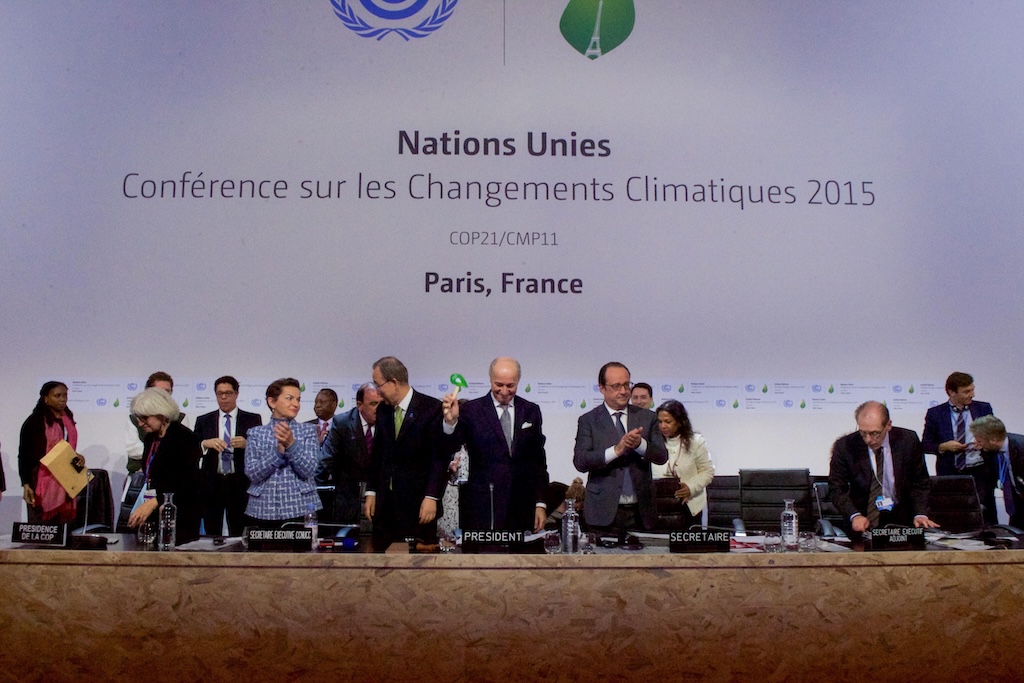
Methane is a short-lived gas that only remains in the atmosphere for around 12 years before breaking down. But it causes a large burst of initial warming that is around 80 times more powerful than CO2, according to the IPCC.
This means that one tonne of methane causes the same amount of warming as around 80 tonnes of CO2, when measured over a period of 20 years.
When calculated over 100 years, methane’s shorter lifetime means it causes around 30 times more warming than CO2.
Some experts have criticised the use of GWP100, saying it does not sufficiently account for the fact that methane leaves the atmosphere much more quickly than CO2 and does not actually last for 100 years. This is the issue that GWP* was designed to fix.
GWP* calculates the warming contributions of long- and short-lived gases at different rates, accounting for their varying lifetimes in the atmosphere.
One of the researchers behind GWP*, Dr Michelle Cain, explained in a 2018 Carbon Brief guest post that a constant rate of methane emissions can maintain stable atmospheric concentrations of the gas, assuming methane sinks remain constant as well.
In contrast, a constant rate of CO2 emissions “leads to year-on-year increases in warming, because the CO2 accumulates in the atmosphere”, Cain wrote. CO2 does not leave the atmosphere after a decade or so, as methane does, and continues to build over time until emissions stop.
Cain, formerly a researcher at the University of Oxford and now a senior lecturer at Cranfield University, added:
“For countries with high methane emissions – due to, say, agriculture – this can make a huge difference to how their progress in emission reductions is judged.”
Methane emissions that slowly decline or remain stable over time are calculated as contributing “no additional warming” to the planet, which is not the case with other GWP calculations.
The chart below shows simplified emissions scenarios for CO2 and methane, highlighting the different impacts they have on global warming over time.
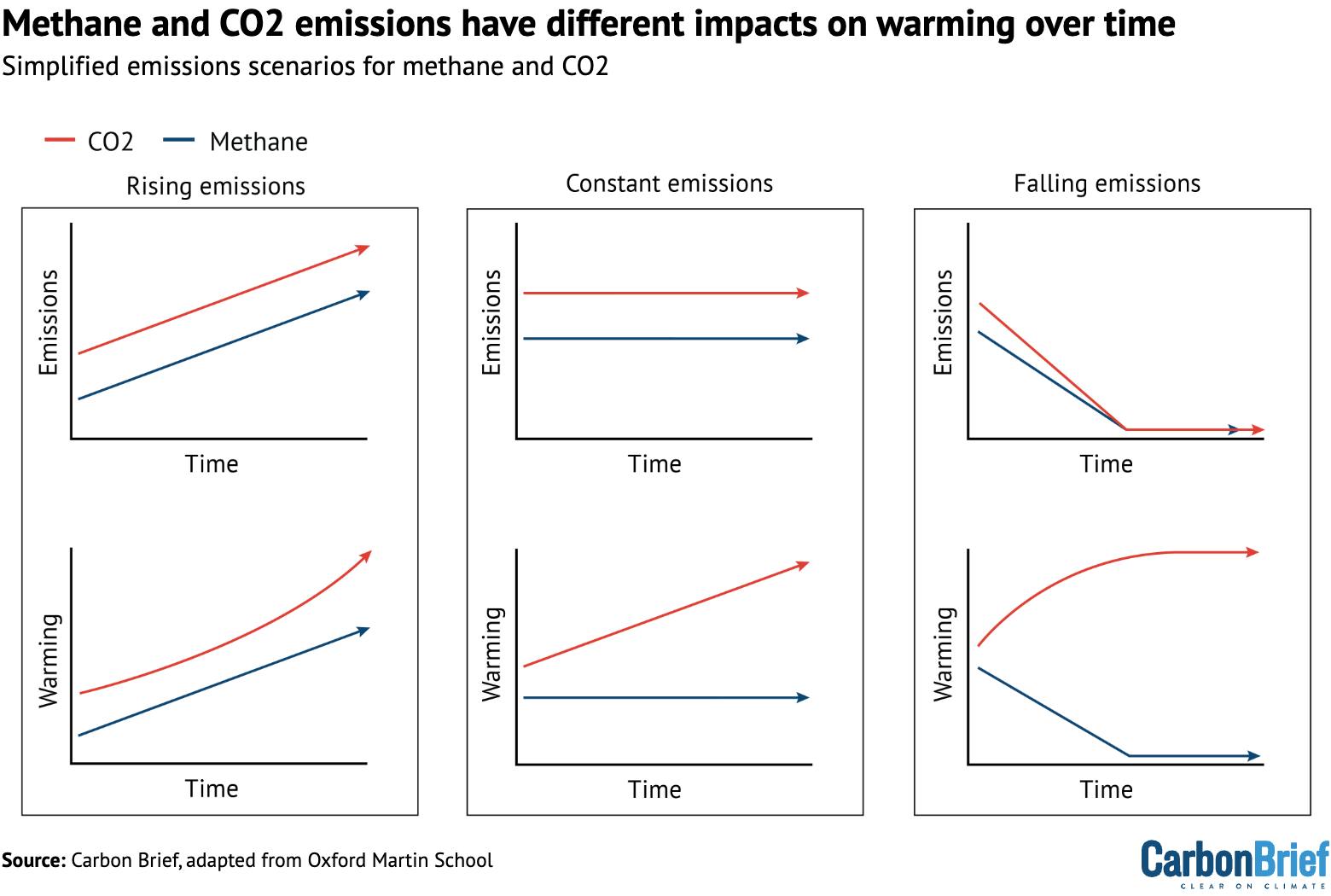
The chart below shows how using the two different metrics – GWP* and GWP100 – affects the same emissions pathway throughout the 21st century, given the different warming impacts of greenhouse gases.

If, for example, a country emitted 4m tonnes of methane annually from 1990-2005, these emissions would now be considered “climate-neutral” using GWP*, as they are not actively contributing new warming to the atmosphere, but rather maintaining the existing levels of methane in the atmosphere in 1990.
This would not be the case under GWP100, which looks at the warming potential of emissions over the course of a century and does not account for their different atmospheric lifetimes.
GWP* can be used for other short-lived gases, such as some hydrofluorocarbons, but methane is the most significant short-lived gas when it comes to climate change.
The IPCC notes that converting methane emissions into CO2 equivalent using GWP100 “overstates the effect of constant methane emissions on global surface temperature by a factor of 3-4” and understates the impact of new methane emissions “by a factor of 4-5 over the 20 years following the introduction of the new source”.
GWP* was created by several researchers, including Prof Myles Allen, the head of atmospheric, oceanic and planetary physics at the University of Oxford. The concept was detailed in a 2016 study and first named in a 2018 study. It was further updated by the authors in 2019 and 2020.
Allen tells Carbon Brief that the researchers involved were “reluctant” to give their new metric a name, as it “was just a way of using reported numbers to calculate warming impact”. He adds:
“I think it’s really unfortunate that people have latched onto GWP*. It doesn’t matter. We could forget about GWP* entirely, we can just use a climate model to work out the warming impact…GWP* is a handy way of calculating the warming impact of activities. Nothing more.”
What are the main controversies around using GWP*?
Efforts to cut methane emissions are widely viewed as a “quick-win” to help limit the effects of climate change in the short term.
More than 100 countries signed a pledge, launched at COP26 in 2021, to cut global methane emissions by 30% by 2030.
Cutting methane would also help to counteract an acceleration in warming due to declining aerosol emissions, which are currently masking around half a degree of warming.
Experts Carbon Brief spoke to agree on the importance of cutting methane emissions, but disagree on whether GWP* helps or hinders these efforts.
The debate around the metric centres on the possible impacts of its use, rather than the soundness of the science behind it.
Prof Joeri Rogelj, a climate science and policy professor at Imperial College London, explains:
“At the global level, at any level, the method of GWP* actually provides a good, new way to translate the trajectory of methane emissions into equivalent emissions of CO2, or emissions of CO2 that would have an equivalent warming effect…The debate is on the application.”
Allen says he is a “little frustrated” that discussions around the use of GWP* have “become so emotive”. He tells Carbon Brief:
“Every action we take has both a temporary impact on global temperature and a permanent one. How much is in both areas depends on the action. We need to know those two things in order to make decisions about choices of action in pursuit of a temperature goal…GWP* gives you a handy way of doing that.”
Below, Carbon Brief details some of the main discussion points and controversies around GWP*.
Carbon cycle
A misleading claim frequently made about livestock is that cows do not contribute much to global warming because the methane they emit eventually returns to the land through the carbon cycle – the set of processes in which carbon is exchanged between the atmosphere, land and ocean, as well as the organisms they contain.
Those in favour of using GWP* to measure methane emissions often also stress the difference between methane emissions that come from animals – known as biogenic methane – and methane from fossil fuels.
Rogelj tells Carbon Brief that biogenic and fossil-sourced methane are “slightly different, but that difference is really second-order” when it comes to climate change.
Methane warms the planet while it is in the atmosphere, so the “climate effect is exactly the same, irrespective of which source the methane comes from”, Rogelj adds.
The differences become more significant when methane breaks down in the atmosphere and oxidises into water vapour and CO2.
CO2 that originated from a cow can be reabsorbed by plants and the land. But the CO2 resulting from fossil methane – which stems from sources such as flaring from oil and gas drilling – stays in the atmosphere. Although fossil methane has a “bit of a longer effect”, Rogelj says:
“This is a bit of a red herring, because the main effect is, of course, the effect that the methane has while it is methane and not what the carbon molecule of that methane has after [the] methane has been broken down or oxidised to CO2.”
He adds that there are ways of reducing agricultural methane, such as “diet change” or “management measures”, but no way to remove the emissions “100%”.
The graphic below shows the digestive process through which a cow emits methane.
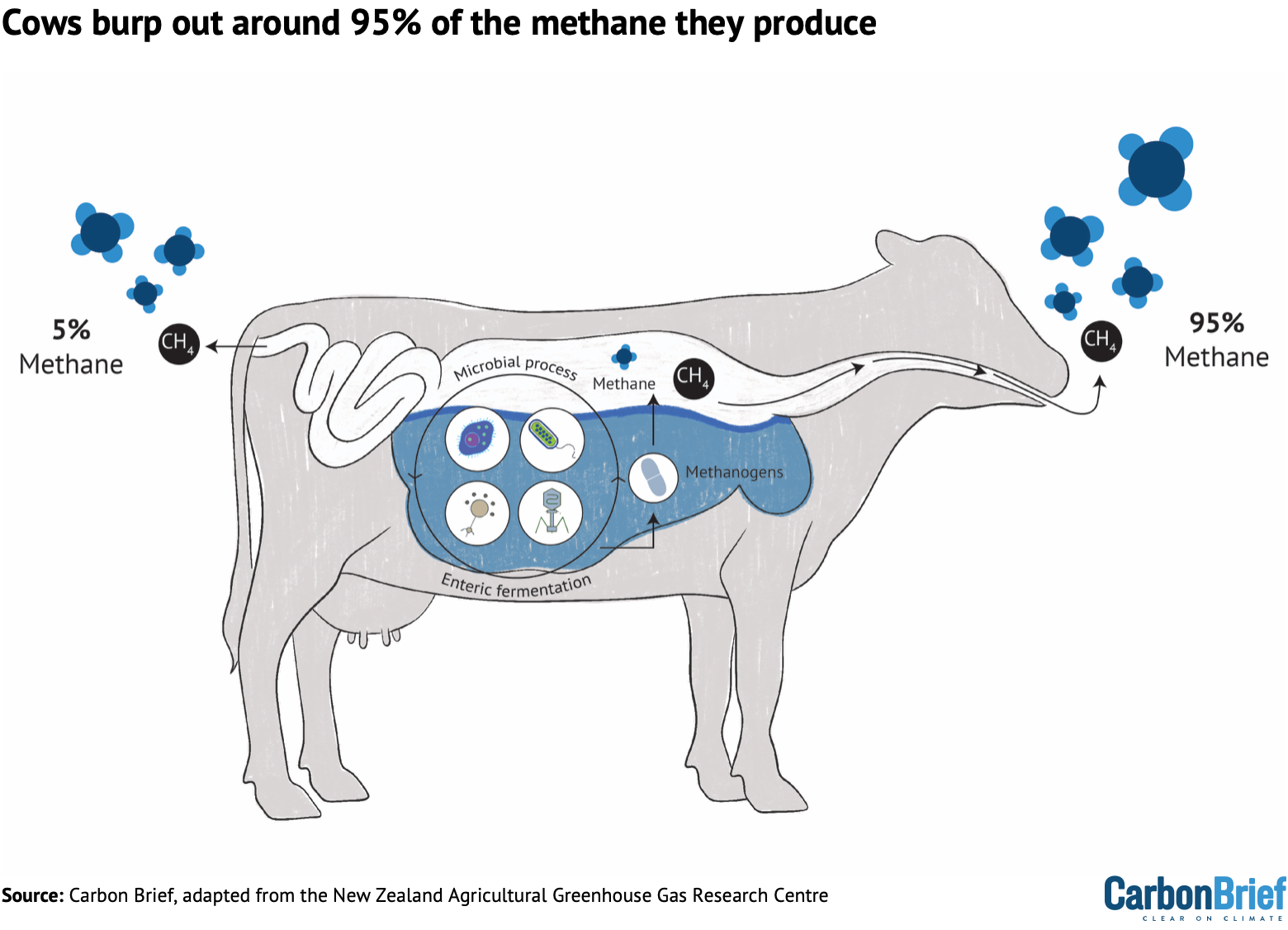
Agriculture also causes other significant environmental harms. It is responsible for around 80% of global deforestation and is a key driver of biodiversity loss and water pollution.
Prof Frank Mitloehner, a professor and air-quality specialist at the University of California, Davis (UC Davis), is one of the main proponents of GWP*, frequently speaking about it in public presentations and discussions with the farming sector.
He tells Carbon Brief that, while animal agriculture can cause environmental harm, it is a “silly argument” to say these impacts are being ignored in carbon-cycle discussions.
He gives an example of discussions on deaths from car accidents excluding mentions of the emissions from cars, saying that these wider impacts are still important and can be discussed separately.
He adds that it is an “urban myth” that biogenic methane emissions are not a concern because of the carbon cycle.
‘No additional warming’
Under GWP*, methane emissions stop causing new warming once they reduce by 10% over the course of 30 years – around 3% each decade, or 0.3% each year.
These emissions are then described in research and policy as causing “no additional warming”.
For example, a 2021 study from Mitloehner and other UC Davis researchers, found that methane emissions from the US cattle industry “have not contributed additional warming since 1986”, based on GWP* calculations. It also said that the dairy industry in California “will approach climate neutrality” by the 2030s, if methane emissions are cut by just 1% annually.
(According to the US Environmental Protection Agency, methane emissions from enteric fermentation – the digestive process through which cows produce the greenhouse gas – increased by more than 5% over 1990-2022.)
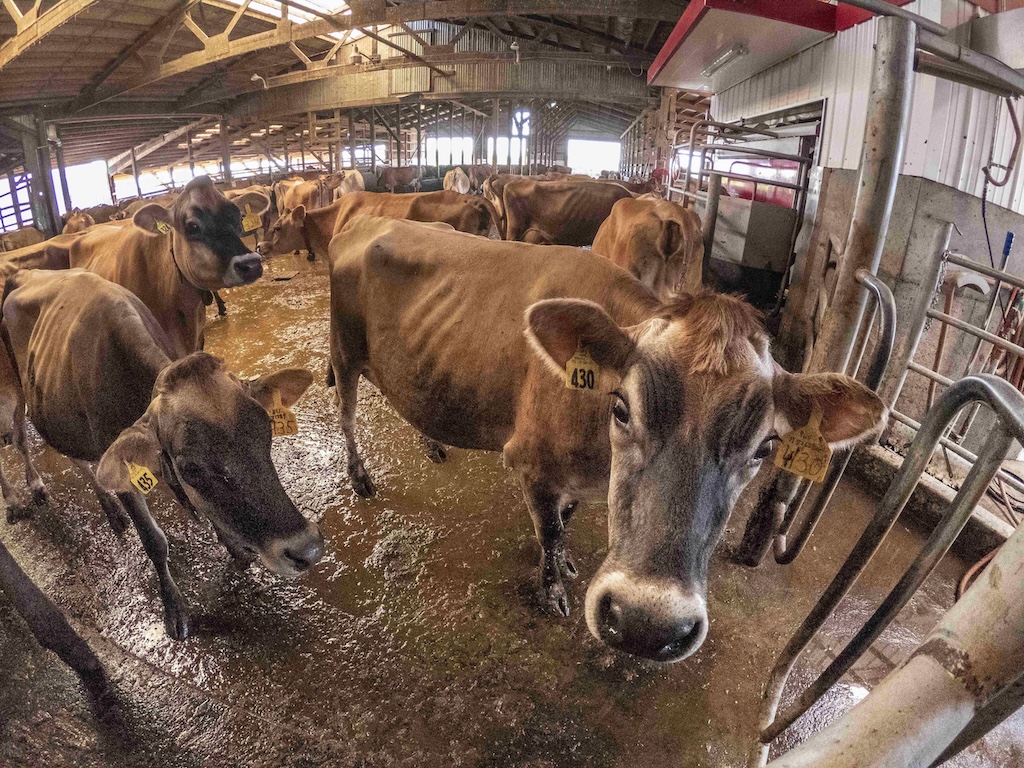
However, many critics take issue with the “no additional warming” concept.
The main criticism is that, although a gradually reducing herd of cattle may stabilise methane emissions, it still emits the polluting gas. If animal numbers were instead drastically reduced, this would cut methane emissions and lower warming rather than maintaining current levels.
Dr Caspar Donnison, a postdoctoral researcher at Lawrence Livermore National Laboratory in the US, says the term no additional warming is “absolutely misleading” in the context of GWP*. He tells Carbon Brief:
“You just assume, on the face of it, that this means it has a neutral impact on the climate…But ‘no additional warming’ means that you’re still sustaining the warming that the herd is causing.”
Allen says that the debate focuses on the “stock of warming versus additional warming”. He compares it to accounting for historical emissions of CO2:
“If a country got rich by burning CO2, they’ve caused a lot of warming in the past. If they reduce their CO2 emissions to zero, then people are generally happy to call what they’re doing climate-neutral, even though they may be sitting on a huge heap of historical warming caused by their CO2 emissions while they were burning [fossil fuels].
“And yet, temperature-wise, that’s exactly the same thing as having a source of methane that’s declining by 3% per decade.”
Climate ambition
Another criticism around the use of GWP* is that countries or companies with high agricultural methane emissions could use the metric to make small emission reductions appear larger.
Dr Donal Murphy-Bokern, an independent agricultural and environmental scientist, believes that the metric can be used as a “get-out-of-jail-free card for methane emitters”. He adds:
“It’s all about saying carry on as we are; we’ll manage this by slightly reducing our emissions over a critical period in history, so as to appear at that critical period in history to be so-called ‘climate-neutral’.”
Mitloehner disagrees with this, noting that, while reductions in methane emissions appear significant under GWP*, increases also appear significant. He says:
“It is simply not true that GWP* is a get-out-of-jail-free card. It’s not. If you reduce emissions, it makes your contributions look less. If you increase emissions, it makes your contributions much worse.”
Rogelj says he has not seen GWP* being used to advocate for the “highest possible ambition” in cutting methane emissions.
However, Allen says that “no metric tells you what to do”. He adds:
“How you measure emissions and how you measure warming has absolutely no bearing on whether you think a country has an obligation to undo some of the damage to the climate they’ve caused in the past.
“This is where the ‘free-pass’ argument makes no sense to me, because the existence of a method to calculate the warming impact of your emissions allows you to make decisions about emissions in light of their warming impact, sure, but it doesn’t tell you what the outcomes of those decisions should be.”
Allen adds that the livestock sector is “unsustainable globally”, with animal numbers and methane levels still rising.
The chart below shows how atmospheric methane concentrations have increased in recent decades.

Allen tells Carbon Brief:
“Do we need to eliminate livestock agriculture to stop global warming? No…[but] we do need to start decreasing it. And if we can decrease it faster than 3% per decade then that would help reduce warming that’s caused by other sectors or, indeed, undo some of the warming that the livestock sector has caused in the past.”
Mitloehner says considerations on the fairness of using GWP* are “real from a policy standpoint and they have to be addressed from a policy standpoint”. He adds:
“But, from a scientific standpoint – and that’s where I’m coming from – I think it’s not controversial.”
Baseline and historical emissions
The baseline year from which emissions reduction targets are set is significant, as it helps form the scope of climate ambition.
For example, high-emitting countries, such as the UK, have set 1990 as their baseline year for emissions-cutting targets, whereas many low-emitting countries may choose further back or more recent years, depending on their needs. Rogelj says:
“Because GWP* translates a change in emissions into either an instantaneous emission or instantaneous removal of CO2, your starting point becomes really important.
“If you start with very high emissions of methane and you did not in any way account for this high starting point, then even very minor, unambitious reductions in methane would result in creating credits for high-polluting countries.”
However, he notes that this is just one way of applying the metric and that there could be ways to avoid this “inequitable outcome”, such as applying GWP* globally and allocating each country a per-capita methane budget, instead of assessing based on national current or past emissions. (Rogelj and Prof Carl-Friedrich Schleussner discussed other possible GWP* equity measures in a 2019 study.)
The chart below, adapted from that study, shows how GWP* can significantly change the per-capita methane emissions of different countries. Some countries with high agricultural methane emissions, such as New Zealand, change from high to low per-capita emitters.
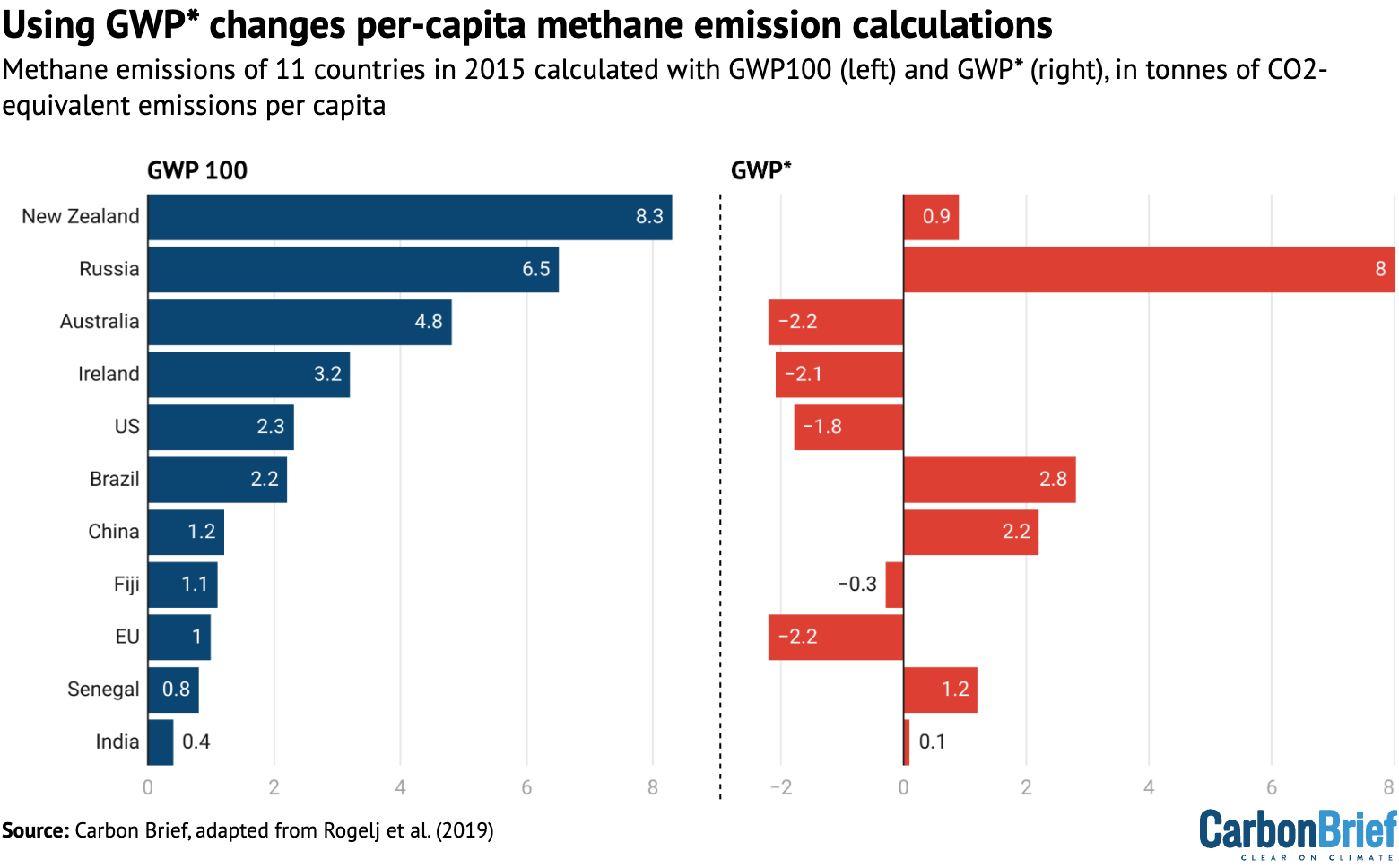
A 2025 study used a climate model to quantify future national warming contributions for Ireland under different emissions scenarios and found that “no additional warming” approaches, such as GWP*, are “not a robust basis for fair and effective national climate policy”.
Discussing baseline concerns, Allen says these considerations are the same for any other metric:
“It depends on how much account you want to take of [the] warming you’ve caused in the past – and at what point you want to take responsibility for the warming your actions had caused.”
He believes that most climate experts agree that it is good to understand the impact emissions have on global temperatures, but “where the controversy arises is about what you consider someone’s nominal emissions to be today”. He adds:
“This is where everybody gets upset, because if you use GWP*, then a livestock sector that’s reducing its emissions by 3% per decade – which most global-north livestock sectors are doing – it looks like their emissions are quite small.
“But that’s only a problem if you think that the main issue is working out whose fault global warming is, rather than working out what we should do about it.”
Communication
Many experts Carbon Brief spoke to took issue with how GWP* has been discussed by some of its proponents.
Murphy-Bokern criticises how Mitloehner and other experts communicate the metric. He says:
“The confusion arises from the activities of Mitloehner, in particular, where he presents the farming community – and the industry in general – with the idea that you can magic away the warming effect of methane simply by looking at the rate of change of methane emissions.”
Mitloehner says he has no regrets about his communication of GWP*, adding that he has “always emphasised to the livestock sector that reductions of methane are important”. He tells Carbon Brief:
“I’m proud because I have been able to take the livestock sector along with the understanding that reductions are needed and that they can be part of a solution if they understand that.”
The New York Times reported in 2022 that the research centre led by Mitloehner at the University of California, Davis “receives almost all its funding from industry donations and coordinates with a major livestock lobby group on messaging campaigns”. Other reports note his discussions about GWP* with stakeholders in various countries.
In response to these reports, Mitloehner says he believes it is important to work with the sector you are researching, adding that he receives both public and private funding. He tells Carbon Brief:
“The problem is not that they [the meat industry] are investing in research and communications and extension. The problem is that they are not putting in enough, because the public sector is withdrawing from this.
“Climate research is being slashed…If the government is not paying into research to quantify and reduce emissions – and those people who are critical of what we do say ‘oh, industry shouldn’t do it’ – then, I ask you, who should?”
Colin Woodall, the chief executive of the National Cattlemen’s Beef Association, a US lobby group, said in 2022 that GWP* is the “methodology we need to make sure everybody is utilising in order to tell the true story of methane”, Unearthed reported. According to the outlet, he added:
“We’re working with our partners around the globe to ensure that everybody is working towards adoption of GWP*.”
Asked if he regrets anything about his communication of GWP*, Allen tells Carbon Brief:
“When we first introduced this – and, perhaps, this is one thing I do regret – I was, perhaps, a little naive in that I thought everybody would seize on focusing on [the] warming impact because it was, from a policy perspective, potentially much easier for the agricultural sector.
“I thought that this would actually be welcomed. But, sadly, it’s not been. And I think part of that is because of this narrative of blame.”
Do any countries currently use GWP* to measure methane emissions?
GWP* is not yet used by any country in methane emission reporting or targets. But it has been considered by New Zealand, Ireland and other nations with high agricultural emissions.
A 2024 statement from dozens of NGOs and environmental organisations called for countries and companies not to use GWP* in their greenhouse gas reporting or to guide their climate mitigation policies. They wrote:
“The risks of GWP* significantly outweigh the benefits.”
New Zealand
New Zealand is currently considering changing its biogenic methane target, including applying the “no additional warming” approach used in GWP*. If it does so, it could become the first country to adopt GWP*.
The nation is a major livestock producer and agriculture generates nearly half of all its greenhouse gas emissions.
The chart below shows that the agricultural sector is also responsible for more than 90% of the country’s methane emissions.
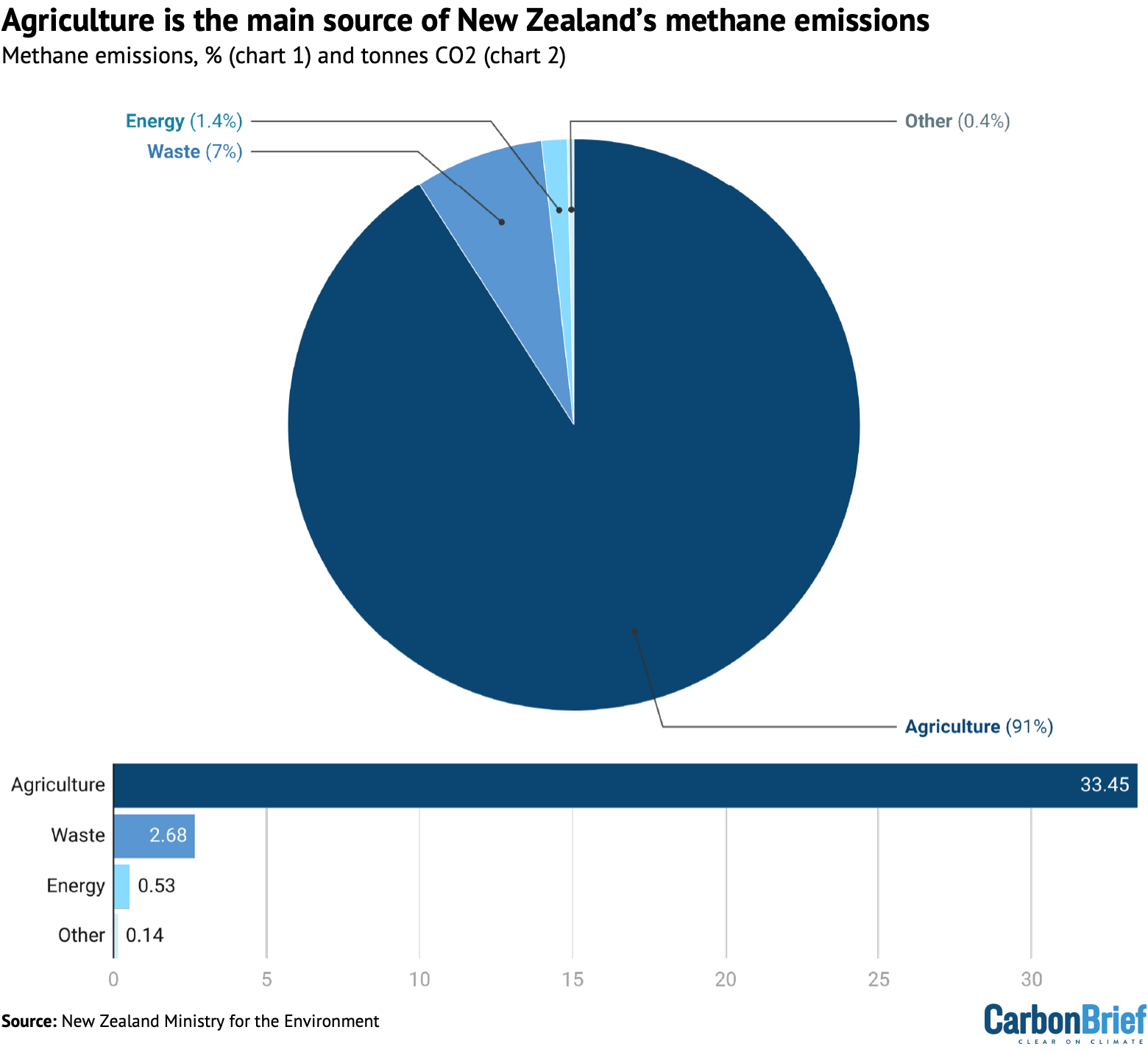
New Zealand has a legally binding target to reach net-zero greenhouse gas emissions by 2050. However, biogenic methane has separate targets to reduce by 10% by 2030 and by 24-47% by 2050, compared to a baseline of 2017 levels.
In late 2024, a review from the nation’s Climate Change Commission recommended that the government change its 2050 greenhouse gas targets, including to increase the biogenic methane goal to a 35-47% reduction by 2050.
At the same time, an independent panel commissioned by the New Zealand government reviewed how the country’s climate targets would look under the “no additional warming” approach.
The resulting report, which did not look specifically at GWP*, but used a similar concept, found that a 14-15% cut in biogenic methane by 2050 would be “consistent with meeting the ‘no additional warming’ condition”, under mid-range global emissions scenarios that keep temperatures below 2C.
The government is “currently considering” these findings, a spokesperson for the Ministry for the Environment tells Carbon Brief in a statement.
The spokesperson says that the report is “part of the body of evidence” that the government will use in its response to the Climate Change Commission’s review, which it must publish by November 2025.

Cain, the Cranfield University lecturer who co-created GWP*, wrote in Climate Home News in 2019 that New Zealand reducing biogenic methane by 24% would “offset the warming impact” of the rest of the country’s emissions, adding:
“New Zealand could declare itself climate-neutral almost immediately, well before 2050 and only because farmers were reducing their methane emissions. That’s a free pass to all the other sectors, courtesy of New Zealand’s farmers.”
A report on GWP* by the Changing Markets Foundation found that, in 2020, 16 industry groups in New Zealand and the UK “urged” the UN’s Intergovernmental Panel on Climate Change to use GWP* to assess warming impacts.
Australia
The Guardian reported in May 2024 that Cattle Australia, a cattle producer trade group, was “lobbying the red-meat sector to ditch its net-zero target in favour of a ‘climate-neutral’ goal that would require far more modest reductions in methane emissions”.
Cattle Australia’s senior adviser and former chief executive, Dr Chris Parker, tells Carbon Brief in a statement that the organisation is “working with the Australian government to ensure methane emissions within the biogenic carbon cycle are appropriately accounted for in our national accounting systems”. He adds:
“We believe GWP* offers a more accurate way of assessing methane’s temporary place in the atmosphere and its impact on the climate. Australian cattle producers are part of the climate solution and we need policy settings to enable them to participate in carbon markets.”
Australia’s Department of Climate Change, Energy, the Environment and Water did not respond to Carbon Brief’s request for comment.
Ireland
Internal documents assessed for the Changing Markets Foundation’s GWP* report “suggest” that Ireland’s Department of Agriculture, Food and the Marine has advocated for GWP* “at the international level”, including at the UN’s COP26 climate summit in 2021.
Allen and Mitloehner were involved in a 2022 Irish parliamentary discussion on methane, in which Allen advocated for the country to “be a policy pioneer” by using GWP* in its methane reporting alongside standard methods.
The country’s coalition government, formed earlier this year, pledged to “recognise the distinct characteristics of biogenic methane” and also “advocate for the accounting of this greenhouse gas to be re-classified at EU and international level”.
A spokesperson for Ireland’s Department of Agriculture, Food and the Marine tells Carbon Brief that this does not refer to using GWP* specifically. They say the country is “in favour of using accurate, scientifically validated and internationally accepted emission measurement metrics”, adding:
“It is important that the nature of how biogenic methane interacts in the environment is accurately reflected in how it is accounted for. This does not mean the use of the metric GWP*.”
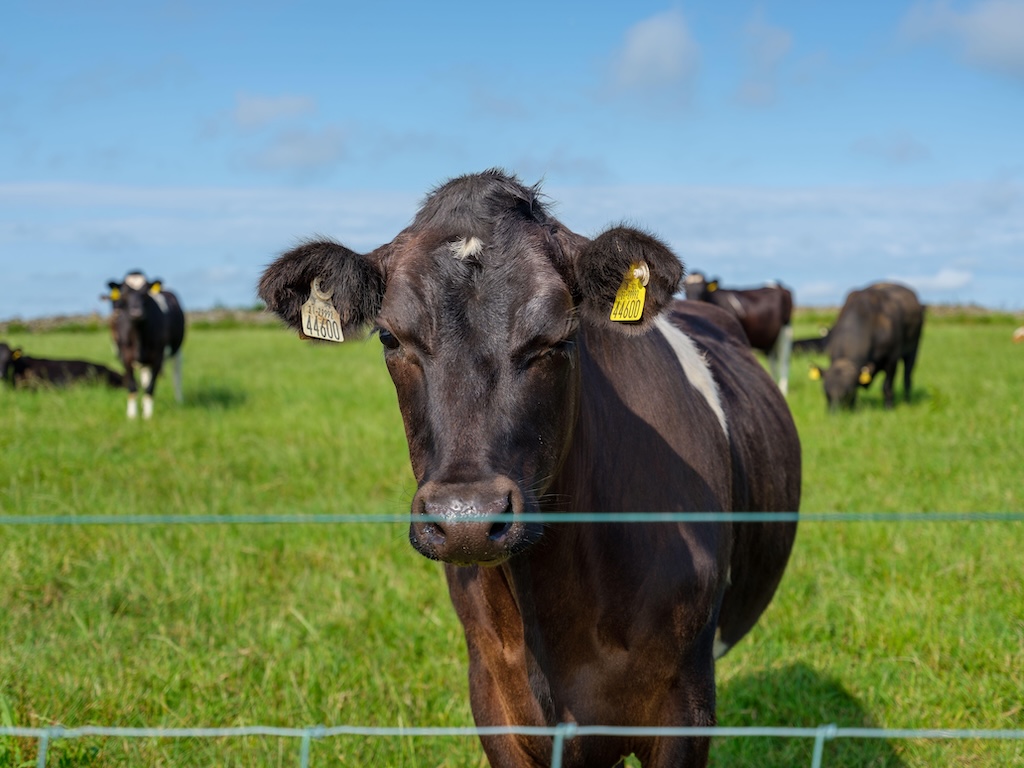
In December 2024, Ireland’s Climate Change Advisory Council proposed temperature neutrality pathway options to the government that do not specifically refer to GWP*, but use the same concept of no “additional warming”.
The Irish Times reported that this was “in part to reduce potential disruption from Ireland’s legal commitment to achieve national ‘climate neutrality’ by 2050”.
The climate and energy minister, Darragh O’Brien, said he has “not formed a definitive view” on this, the newspaper noted, and that expert views will feed into ongoing discussions on the 2031-40 carbon budgets, which are due to be finalised later in 2025.
In an Irish Times opinion article, Prof Hannah Daly from University College Cork, described the temperature neutrality consideration as “one of the most consequential climate decisions this government will make”. She wrote that the approach “amounts to a free pass for continued high emissions” of livestock methane.
Paraguay
Paraguay mentioned GWP* in a national submission to the UN in 2023 after agribusiness representatives “pushed” to adopt the metric, according to Consenso, a Paraguayan online newsletter.
The country’s National Directorate of Climate Change told Consenso for a separate article related to GWP* that it is “aware” of questions around the metric, but that it “has the option of using other measurement systems” for emissions reporting.
UK
The National Farmers’ Union, the main farming representative group in England and Wales, is in favour of using GWP* to measure agricultural methane emissions.
Carbon Brief understands that the UK government is not currently considering using GWP* in addition to, or instead of, GWP100 in its emissions reporting.
What do experts think about the use of GWP*?
Most experts Carbon Brief spoke to agreed that GWP* could be a useful metric to apply to global methane emissions, but that it is difficult to apply equitably in individual countries or sectors. Rogelj believes that are are some contexts in which GWP* could be used, but adds:
“You cannot just take targets that were set and discussed historically with one greenhouse gas metric in mind – GWP100 under the UNFCCC [United Nations Framework on Climate Change] and the Paris Agreement and all that – [and] then simply apply a different metric to it. They change meaning entirely.
“So, if one would like to use GWP*, one should build the policy targets and frameworks from the ground up to take advantage of the strengths of that metric, but also put in place safeguards that ensure that the weaknesses and limitations of that metric do not result in unfair or undesirable outcomes.”
A 2022 study says that using GWP* in climate plans “would ask countries to start from scratch in terms of their political target setting processes”, calling it a “bold ask” for policymakers.
It adds that achieving net-zero emissions, as measured with GWP*, “would only lead to a stabilisation of temperatures at their peak level”.
However, a 2024 study found that GWP* gives a “dynamic” assessment of the warming impact of emissions that “better aligns with temperature goals” than GWP100, when measuring methane emissions from agriculture.
Allen believes that criticism over the use of GWP* is similar to “saying it’s a meaningless question” to consider the warming impact of a country or company’s actions. He adds:
“That seems a very strange position to me, because we need to know how different activities are contributing to global warming because we have a temperature target.
“In saying GWP* is a bad thing, what people are actually saying is it’s a bad thing to know the warming impact of our actions, which is a very strange thing to say.”
He says that such metrics help countries to make informed decisions on climate action, but that “we can’t expect metrics to make these decisions for us”.
Murphy-Bokern notes that GWP* could be useful in modelling global, rather than national, methane emissions to avoid high-emitting countries making small methane cuts to achieve “no additional warming”, rather than significantly reducing these emissions.
He says the metric would be particularly useful if global emissions were close to zero, as a way to target the final remaining emissions. But, he adds:
“We are so far away from that very happy situation, that the discussion now with GWP* is a huge distraction from the key objective, which is to reduce emissions.”
Mitloehner – and every expert Carbon Brief spoke with – agrees with this wider point. He says:
“The main point is we need to reduce emissions. In the case of livestock, we need to reduce methane emissions. And the question is how do we get it done? And how do we quantify the impacts that [that reduction] would have accurately and fairly? The other issues are issues that politicians have to answer.”
The post Q&A: What the ‘controversial’ GWP* methane metric means for farming emissions appeared first on Carbon Brief.
Q&A: What the ‘controversial’ GWP* methane metric means for farming emissions
Greenhouse Gases
EAT-Lancet report: Three key takeaways on climate and diet change
A global shift towards “healthier” diets could cut non-CO2 greenhouse gas emissions, such as methane, from agriculture by 15% by 2050, according to a new report.
The EAT-Lancet Commission report on “healthy, sustainable and just food systems” says this diet would require producing more fruit, vegetables and nuts, as well as fewer livestock.
The findings build on the widely cited 2019 report from the EAT-Lancet Commission – a group of leading experts in nutrition, climate, economics, health, social sciences and agriculture from around the world.
The new report notes that one-third of all greenhouse gas emissions come from the global food system.
These emissions are so great that, even if all fossil fuels were phased out, “food can on its own push us beyond the 1.5C limit”, one of the commission co-chairs, Prof Johan Rockström, told a press briefing.
The report details a “planetary health diet” – a concept first introduced in the 2019 report – which focuses on “plant-rich” and “minimally processed” foods.
The latest edition builds on the previous report by adding improved modelling of food-system transformation and adding social-justice considerations.
The 2019 report faced a “massive online backlash” against some of its findings, particularly on cutting meat consumption, DeSmog reported earlier this year, which was “stoked by a PR firm that represents the meat and dairy sector”.
Rockström said the commission is “ready to meet that assault” if it arises again and issued concern “over this return of mis- and disinformation and denialism on climate science”.
Here, Carbon Brief picks out three key takeaways from the latest report.
- A ‘plant-rich’ diet has the best health and climate outcomes
- Transforming food systems could ‘substantially reduce’ the associated emissions
- Social justice should be a ‘central goal’ in transforming global food systems
A ‘plant-rich’ diet has the best health and climate outcomes
The new report recommends a plant-rich “planetary health diet”, which is largely the same as the one first outlined in the 2019 report.
The diet is designed to be flexible and “compatible with many foods, cultures, dietary patterns, traditions and individual preferences”, the report says.
It does not exclude meat or dairy products – the foods that cause the highest emissions – but recommends limited portions, equating to around one glass of milk per day and a couple of servings of meat and two eggs each week, for those whose diets include them.
The chart below outlines the recommended intake of different foods, adding up to around 2,400 calories each day. A range is given for each food type to accommodate different diets. The categories with the largest intakes include whole grains, plant oils, nuts and legumes.

The diet is “designed for health…[not] sustainability”, Dr Line Gordon, a commissioner on the report, told a press briefing.
But the report also analyses the climate impact of the recommendations. It estimates that shifting to the planetary diet could reduce global non-CO2 agricultural emissions – from greenhouse gases such as methane and nitrous oxide – by 15% by 2050. (See: Transforming food systems could ‘substantially reduce’ the associated emissions.)
Widespread adoption of the diet would require a two-thirds increase in fruit, vegetable and nut production and allow for a one-third reduction in livestock meat production, compared to 2020 levels.
Currently, diets across the globe all “deviate substantially” from the report’s recommendations. But the report claims that, due to the planetary diet’s health benefits, around 15 million “avoidable” deaths could be prevented each year if it were widely adopted.
The report also measures how much global food systems contribute to the nine planetary boundaries – a concept of global thresholds for a “safe and just” planet. It finds that food systems are the largest contributor to five breaches of these boundaries, which include changes in the use of land and freshwater.
In terms of steps to move towards the planetary diet, Gordon listed actions such as changing taxes to make healthy foods more affordable, clearly labelling foods and shifting agricultural production subsidies towards healthier foods.
The report highlights that “transforming food systems is not only possible, it’s essential to securing a safe, just and sustainable future for all”, Rockström says in a statement.
Transforming food systems could ‘substantially reduce’ the associated emissions
Food systems are responsible for about one-third of human-driven greenhouse gas emissions.
These emissions are roughly equally partitioned between livestock and crop production, land-use change and other aspects of the food system, including refrigeration, fertilisers, transport and retail, according to the report.
The authors use global economic models to determine how different actions towards transforming food systems could affect agricultural production, environmental impact and food prices.
For the baseline, they use a set of “business-as-usual” parameters. This scenario uses SSP2-7.0, a high-emissions pathway under which there is a global population of 9.6 billion people and global warming of 2C above pre-industrial temperatures in 2050.
Using these assumptions, the business-as-usual scenario results in a 37% increase in global agricultural production and a 33% rise in non-CO2 agricultural emissions by 2050, compared to 2020. Crop yields increase by nearly one-quarter in this scenario, while the amount of land used for agricultural cultivation expands by 2m square kilometres (km2) – an area roughly the size of Mexico.
The chart below shows the changes in non-CO2 agricultural emissions and agricultural land use under each scenario, with the three main scenarios highlighted in green. The dots indicate the results from different model runs.

The dietary transformation projection assumes a world in which there is total adherence to the suggested diet, a halving of food loss and waste and an additional 7-10% increase in global agricultural productivity.
They find that, in this scenario, agricultural emissions of non-CO2 greenhouse gases decline by 20% compared to 2020 values. Although cropland will have to expand to account for the increased intake of fruits, vegetables and legumes, the decrease in land needed for livestock-rearing means that agricultural land use will fall overall by 3.4m km2, an area the size of India.
The authors also consider a scenario that combines the dietary shifts with “ambitious mitigation” efforts. This includes policies such as carbon pricing and land-use regulations that could drive the adoption of bioenergy, afforestation and renewable energy, the report says.
Under widespread dietary shifts and ambitious mitigation, the report finds that non-CO2 emissions from agriculture will fall by 34% compared to 2020, and the reduction in agricultural land use will double compared to the scenario that only factors in the dietary shifts.
Social justice should be a ‘central goal’ in transforming global food systems
In a step further than its predecessor, the new report assesses justice in global food systems, by analysing the rights to food, a healthy environment and decent work.
The focus on social equity and justice added a “tremendous broader aspect” to the report, Dr Shakuntala Thilsted, one of the commission co-chairs, said in a briefing.
The report notes that more than half of the world’s population struggles to access healthy diets, which leads to “devastating consequences for public health, social equity and the environment”.
This primarily affects marginalised people living in low-income regions, it says.
The report finds that the diets of the world’s richest 30% of the population contribute to more than 70% of environmental pressures from food systems, such as land use and greenhouse gas emissions. The report says:
“These statistics highlight the large inequalities in the distribution of both benefits and burdens of current food systems.”
Furthermore, living and working in toxic-free environments and stable climate conditions is a “crucial” human right, it adds.
According to the report, “power asymmetries and discriminatory social and political structures” – such as the concentration of power among a small number of agribusiness firms – hinder the fulfilment of those rights.
The report says that social justice, along with environmental sustainability, should be central to global food systems.
It proposes several steps to making healthy, sustainable and just food systems more accessible by 2050: securing decent working conditions, ensuring liveable wages, recognising and protecting marginalised groups and limiting market concentration.

It notes that while taking steps to mitigate climate change will increase food costs – particularly in areas that currently do not consume adequate fruits and vegetables, and where animal-sourced food is less commonly eaten – some of these pressures can be alleviated by introducing subsidies targeted towards those preferred food groups.
Finally, the authors underscore that implementing this diet must consider both cultural context and sustainability.
However, they also warn that meeting these goals requires global action and “transformative change” in both individual and cultural habits.
The post EAT-Lancet report: Three key takeaways on climate and diet change appeared first on Carbon Brief.
EAT-Lancet report: Three key takeaways on climate and diet change
-
Climate Change2 years ago
Spanish-language misinformation on renewable energy spreads online, report shows
-
Climate Change Videos2 years ago
The toxic gas flares fuelling Nigeria’s climate change – BBC News
-
Climate Change2 months ago
Guest post: Why China is still building new coal – and when it might stop
-

 Greenhouse Gases1 year ago
Greenhouse Gases1 year ago嘉宾来稿:满足中国增长的用电需求 光伏加储能“比新建煤电更实惠”
-

 Climate Change1 year ago
Climate Change1 year ago嘉宾来稿:满足中国增长的用电需求 光伏加储能“比新建煤电更实惠”
-
Greenhouse Gases2 months ago
Guest post: Why China is still building new coal – and when it might stop
-

 Carbon Footprint1 year ago
Carbon Footprint1 year agoUS SEC’s Climate Disclosure Rules Spur Renewed Interest in Carbon Credits
-
Renewable Energy3 months ago
US Grid Strain, Possible Allete Sale













